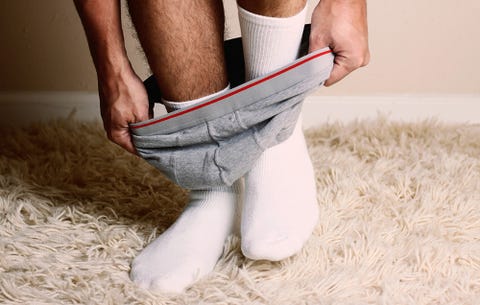Guys, Why Arent You Checking Your Balls For Testicular Cancer?

Scott Petinga, 45, was diagnosed with testicular cancer in 2004. “I was 31 at the time and I had just gotten married and was essentially on my honeymoon when we found the lump,” he told MensHealth.com.
Within a week of diagnosis, he was undergoing surgery, and he also received radiation for the condition. He says it was sheer luck that led to him finding the lump in the first place.
“I was never taught [to check] or be aware of lumps,” he told MensHealth.com.
Petinga is not alone. When it comes to cancer prevention, many guys clearly aren’t paying enough attention to what’s going on down there.
In honor of Testicular Cancer Awareness Month, Petinga’s nonprofit organization, the Center for Advocacy for Cancer of the Testes International (CACTI)polled 1,000 men, asking whether they did self-checks for testicular cancer. Almost half said they did not.
Because the CACTI survey was not conducted by a research institute or medical group, it’s worth taking its findings with a grain of salt. Yet the results are significant, in that they reveal the many misconceptions swirling around testicular cancer. 40 percent of the men surveyed also said they believed they could get testicular cancer from wearing tight underwear, taking a spin class, or having too much sex — none of which are true.
So why are so few men performing regular self-exams? And for that matter, are they even necessary in the first place?
What is testicular cancer?
Testicular cancer is a relatively rare cancer, even though it’s the most common type of cancer in young men ages 15 to 44, says Matthew Campbell, M.D., an assistant professor in the Department of Genitourinary Medical Oncology at The University of Texas MD Anderson Cancer Center, in Houston.
“There are about 8,800 cases per year in the United States,” Campbell told MensHealth.com.
The chance of harm that comes from doing a testicular self exam is virtually none and the potential benefit is high.
“The chance of harm that comes from doing a testicular self-exam is virtually none.”
While it’s not known what causes cancer of the testes, risk factors include an undescended testicle, abnormal testicle development, a family history of the disease, and age (men 15 to 35 are at highest risk), according to the Mayo Clinic.
When caught early, testicular cancer has an excellent survival rate, especially “compared to many other cancers — 95 percent across all presentations — even when it’s widely spread,” says Campbell. That’s why it’s so important that testicular cancer is caught and diagnosed early.
So why don’t men perform regular self-exams?
Public health messages about screening for testicular cancer and self checking can be confusing, says Campbell. The U.S. Preventive Services Task Force does not recommend that teen and adult men get screened regularly for testicular cancer. That means no annual or regular imaging screen tests are necessary, the way women undergo mammograms to screen for breast cancer. The task force recommendation is based on the relatively low incidence of testicular cancer and the “evidence that the benefits of screening for testicular cancer are small to none,” per the organization’s website. There’s also a risk of men developing anxiety as a result of false-positives.
But that doesn’t mean you should table regular self-checks, says Campbell, who recommends a monthly self-exam. “To me, it’s important that all men and women know their own bodies. The chance of harm that comes from doing a testicular self-exam is virtually none and the potential benefit is high,” Campbell says.
Another reason guys don’t check themselves for cancer is that they aren’t taught to do so early in life, says Campbell.
“Young men in this age group tend to be more reluctant to discuss issues related to their genitals because there can be embarrassment and stigma associated with that. A lot of men in this age group will also not have health insurance,” he says.
So how do you do a self-check?
To do a self-exam, hold the top of your left testicle between your thumbs and forefingers, and roll it around gently to feel for lumps. Then do the same thing on the right side. (It helps to do it in the shower, as the humidity and warmth relax your scrotum.)
If you feel any hard lumps or changes in the texture or size of your scrotum, call your doctor and make sure to get yourself checked out, if only to give you some peace of mind.
Give a nod to National Testicular Cancer Awareness Month this April by performing your own self check, and make it a habit every month. For more details, here’s a how-to from the editors of Men’s Health or follow CACTI’s self-exam guide.
Source: Read Full Article
